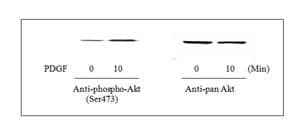AKT1 + AKT2 + AKT3 (pS473) ELISA Kit (ab126432)
Key features and details
- Sample type: Cell Lysate
- Detection method: Colorimetric
- Assay type: Semi-quantitative
- Reacts with: Mouse, Rat, Human
Overview
-
Product name
AKT1 + AKT2 + AKT3 (pS473) ELISA Kit
See all AKT1 + AKT2 + AKT3 kits -
Detection method
Colorimetric -
Sample type
Cell Lysate -
Assay type
Semi-quantitative -
Assay time
5h 00m -
Assay duration
Multiple steps standard assay -
Species reactivity
Reacts with: Mouse, Rat, Human -
Product overview
ab126432 is a very rapid, convenient and sensitive assay kit that can monitor the activation or function of important biological pathways in human, mouse and rat cell lysates. By determining phosphorylated Akt protein in your experimental model system, you can verify pathway activation in your cell lysates. You can simultaneously measure numerous different cell lysates without spending excess time and effort in performing a Western Blotting analysis. (UniprotID: P31749)
This Sandwich ELISA kit is an in vitro enzyme-linked immunosorbent assay for the measurement of human, mouse and rat phospho-Akt (Ser473). An anti-pan Akt antibody has been coated onto a 96-well plate. Samples are pipetted into the wells and Akt present in a sample is bound to the wells by the immobilized antibody. The wells are washed and anti-Akt (Ser473) antibody is used to detect phosphorylated Akt (Ser473). After washing away unbound antibody, HRP-conjugated anti-rabbit IgG is pipetted to the wells. The wells are again washed, a TMB substrate solution is added to the wells and color develops in proportion to the amount of Akt (Ser473) bound. The Stop Solution changes the color from blue to yellow, and the intensity of the color is measured at 450 nm.
Get higher sensitivity in only 90 minutes with AKT 1/2/3 (pS473) ELISA Kit (ab176635) from our SimpleStep ELISA® range.
-
Notes
Abcam has not and does not intend to apply for the REACH Authorisation of customers’ uses of products that contain European Authorisation list (Annex XIV) substances.
It is the responsibility of our customers to check the necessity of application of REACH Authorisation, and any other relevant authorisations, for their intended uses. -
Platform
Microplate
Properties
-
Storage instructions
Store at -20°C. Please refer to protocols. -
Components 1 x 96 tests 20X Wash Buffer Concentrate 1 x 25ml 2X Cell Lysis Buffer 1 x 5ml 5X Assay Diluent 1 x 15ml Akt Microplate (12 strips x 8 wells) coated with anti-pan Akt antibody 1 unit Detection Antibody Akt (Ser473): rabbit anti-phospho-Akt (Ser473) 2 vials 500X HRP-conjugated anti-rabbit IgG 1 x 25µl Positive Control: lyophilized NIH3T3 cell lysate 1 vial Stop Solution 1 x 8ml TMB One-Step Substrate Reagent 1 x 12ml -
Research areas
-
Function
IGF-1 leads to the activation of AKT3, which may play a role in regulating cell survival. Capable of phosphorylating several known proteins. Truncated isoform 2/PKB gamma 1 without the second serine phosphorylation site could still be stimulated but to a lesser extent. -
Tissue specificity
In adult tissues, it is highly expressed in brain, lung and kidney, but weakly in heart, testis and liver. In fetal tissues, it is highly expressed in heart, liver and brain and not at all in kidney. -
Sequence similarities
Belongs to the protein kinase superfamily. AGC Ser/Thr protein kinase family. RAC subfamily.
Contains 1 AGC-kinase C-terminal domain.
Contains 1 PH domain.
Contains 1 protein kinase domain. -
Domain
Binding of the PH domain to the phosphatidylinositol 3-kinase alpha (PI(3)K) results in its targeting to the plasma membrane. -
Post-translational
modificationsPhosphorylation on Thr-305 and Ser-472 is required for full activity (By similarity). Phosphorylated upon DNA damage, probably by ATM or ATR.
Ubiquitinated. When fully phosphorylated and translocated into the nucleus, undergoes 'Lys-48'-polyubiquitination catalyzed by TTC3, leading to its degradation by the proteasome. -
Cellular localization
Cytoplasm. Membrane. Membrane-associated after cell stimulation leading to its translocation. - Information by UniProt
-
Alternative names
- AKT
- AKT1
- AKT1 kinase
see all -
Database links
- Entrez Gene: 208 Human
- Entrez Gene: 207 Human
- Entrez Gene: 10000 Human
- Entrez Gene: 11651 Mouse
- Entrez Gene: 11652 Mouse
- Entrez Gene: 23797 Mouse
- Entrez Gene: 24185 Rat
- Entrez Gene: 25233 Rat
see all
Images
-
The NIH3T3 cells were treated with recombinant human PDGF for 10 minutes to induce phosphorylation of Akt. Serial dilutions of lysates were analyzed in this ELISA.
-
NIH3T3 cells were treated or untreated with recombinant human PDGF for 10 min. Cell lysates were analyzed by Western Blot.
-
NIH3T3 cells were treated or untreated with recombinant human PDGF for 10 min. Cell lysates were analyzed using this phosphoELISA.
-
A431 cells were treated with recombinant human EGF at 37°C for 20 min. Solubilize cells at 4 x 107 cells/ml in Cell Lysate Buffer. Serial dilutions of lysates were analyzed in this ELISA.














